For Provisional Description of Superficial Features
By:
January 19, 2010
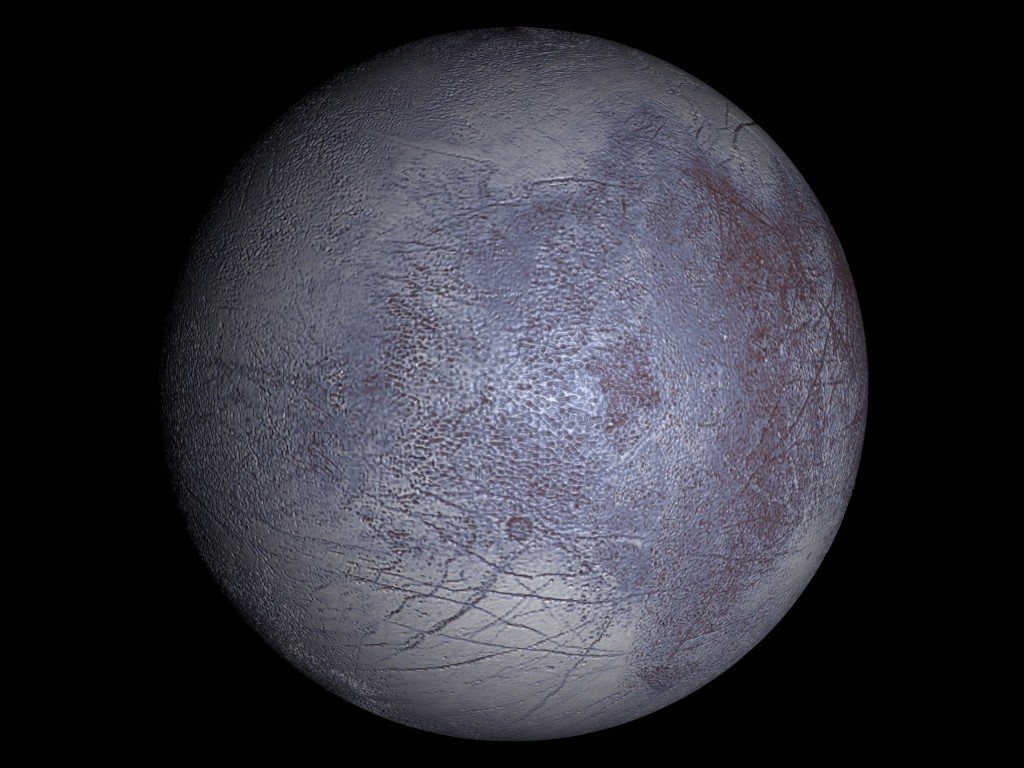
The surface of OGLE-350c, like so many other superearths Sevin and Vulpes had visited, was composed of a mixture of crumbly xenolith and light, rubbery, frozen organics mounded like ice cream — if ice cream were ever black, and piled into geologic deposits that stood weathering in a thin corrosive atmosphere for ten million years. Here and there great cavities yawned in the frozen matrix, dark and questioning. In the distance, perhaps a kilometer away, a long sharp ridge carved into the crepuscular sky, its edge shining spectacularly pink where it caught the light of OGLE-350c’s sun. But that was well out of range, beyond the anti-radiation field thrown out by the lander.
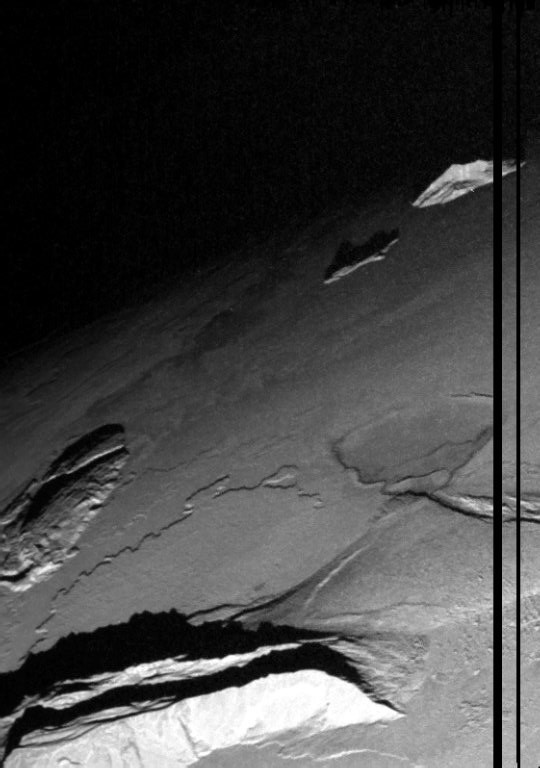
“It’s quite a feature,” Vulpes said. “We should try to reach it on our next trip down.”
Sevin turned from the view of the distant ridge, looking back towards Vulpes and the lander beyond. “I’m beginning my survey,” he said.
“Fine,” Vulpes replied. “I’ll start looking for a place to deploy the density probe.”
They were well matched, Sevin and Vulpes — but nothing less was expected of exploration agents, whose complementary dispositions were artfully chosen and groomed. Where Vulpes was credulous and eager, Sevin was skeptical and high-strung. But these are crude names for the subtly mutual sets of skills and tendencies the two possessed; and their carefully modulated qualities, augmented with judicious neuronal and glandular enhancements, had seen them efficiently from one strange world to another over the long, seasonless years of their mission.
With Vulpes lost to sight, Sevin cranked his helmeted head back and stared into the luminous sky, as if he could see in its stationary orbit the ship that had carried them through wormholes and storms of dark matter to half a dozen worlds before OGLE-350c. But musing on tenuous connections strayed beyond the protocols of his training. Sevin’s mind snapped back to the task at hand, busying himself with click-tagging the geomorphology of various features. It was a simple procedure, one that offered Sevin a too-placid target upon which to concentrate his mental energies. The recorder did all of the work, syncing the measured coordinates with the networked map in the ship’s system seven hundred kilometers above his head. He tried putting aside the mind-numbing cascades of decisions that awaited in the form of search protocols and the dizzying strangeness of the new world itself, but to little avail. He and Vulpes would be on-world three days, until the energy core supplying power to the anti-radiation field was depleted and could be charged no more. Only then would they head back to orbit for a resupply and a few hours of blissful suspension. Then the next mission site would be selected, and they would descend again.
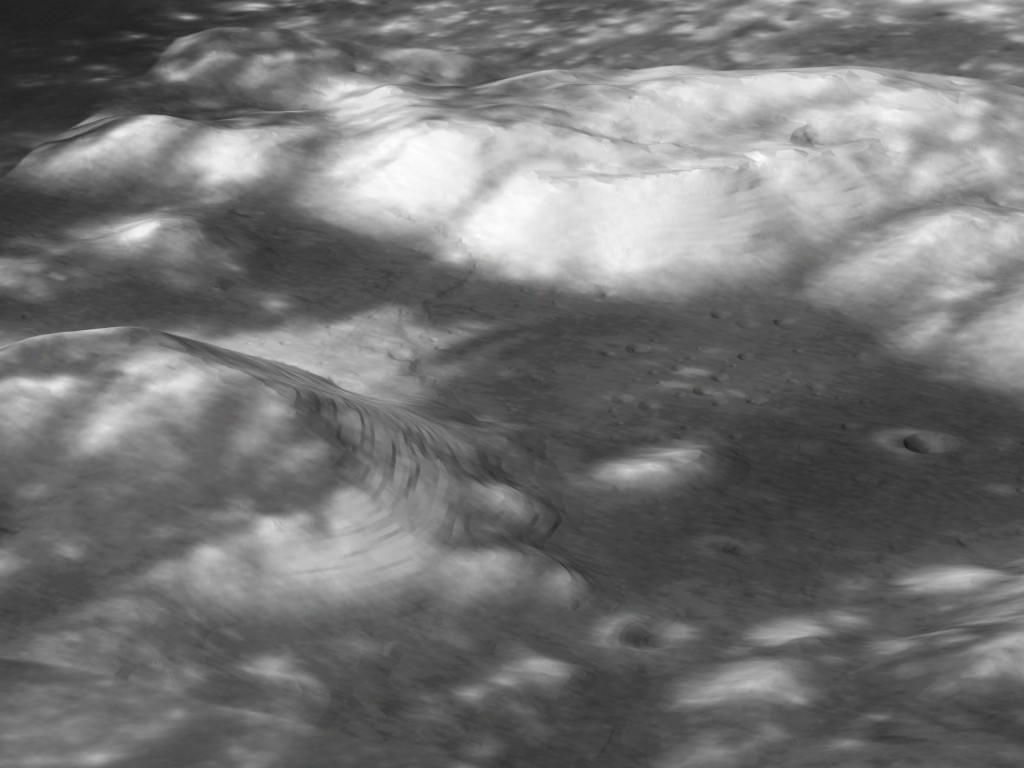
Clicking away with the recorder, Sevin was soon lost in reverie: concentrating on outcrops of xenolith, his mind wandered back through the nebulae, past the torrential labyrinths of energy pouring into black holes and the deadly jets of pulsars, and beyond these things back to Earth and its bacterial seas burping and sloughing in the heat. He was moving along slowly, tagging and pondering, when Vulpes’ voice crackled over the link.
“You’ve got to come see this,” Vulpes said in an uncanny tone.
“What have you got?” Sevin asked. “A notable feature?”
“No,” Vulpes coughed. “Or, yes. It’s something else. Really something else. You’re not going to believe it.”
Sevin waved his hand across his faceplate to activate the heads-up. “I’ve got your position and I’m coming to you now.”
“There is a screen,” Vulpes said, muttering over the link. “And, ah … there are keys.”
“What was that?” Sevin replied.
“They’ve got Internet,” Vulpes said.
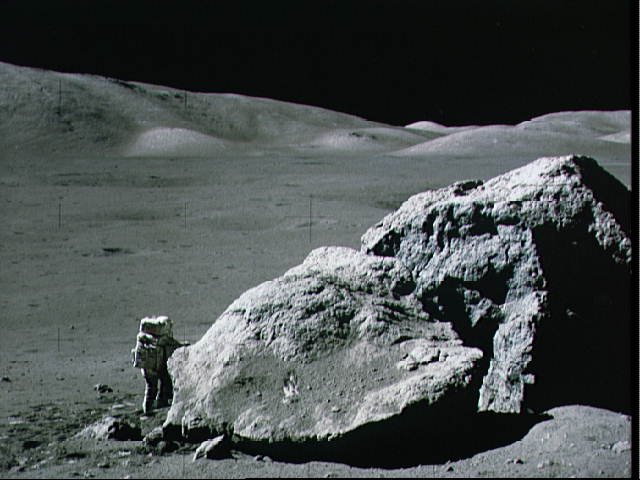
Vulpes’ icon flickered on the augment screen of Sevin’s visor, winking and throbbing among the outlines of burly outcrops of xenolith. Sevin fought his urge to hurry, maintaining a measured pace, remembering to observe, record, reflect, as the protocols admonished. He soon found himself standing before a cavernous opening, a rounded mouth in the xenolith hung with deliquescent methane salts. It was a harrowing prospect, clambering into that maw, and yet Vulpes had done it — even now his icon flashed slightly to the left where, to Sevin’s eyes, there was only a wall of irredeemable rock. He smiled —Vulpes’ placid courage was a benefit, even if his rushed judgments could prove less useful. And now he saw flickering in the hole the unmistakable icy blue of Vulpes’ light diode.
The passage sloped gently downward and made a sharp left turn, then a right. Sevin crouched slightly to enter the chamber that now glowed with Vulpes’ diode. The room — it could only be called a room — was not large, although its ceiling was high. It presented a nearly-incomprehensible sight: the walls and floor seemed fashioned, almost hewn, from the dead rock with rough linearity — but rose upwards into a twisting kind of narrow dome, almost as if the room had been held aloft by some giant hand and spun while the rock was still hot and taffy-soft. From the lower ramparts of this dizzying ceiling, great loops or coils of rock depended, their filaments the thickness of an arm, reaching almost to the floor. Near the far wall stood a desk — it could only be called a desk — upon which sat a pedimented flat panel that bathed Vulpes’ visor with its light. It was this in fact, and not his diode, that lit the room. The many-legged density probe lay upon the floor behind him, undeployed.
Vulpes was staring at the screen and tapping at keys arrayed on neatly on a long tablet — a keyboard — lying on the desk before him. Since the emergence of Ubiquity around 2100, there had been little use for screens and keys — when everything is effectively a screen in potentia, nothing needs to be a screen in fact. And so sets like the one on the desk were quaint — still useful, like transistor radios in the early 2000s; rare, but not exactly collectible. Most had been ground by disuse and abandonment to the plastic dust, or “flash,” that glutted the seashores and sometimes rose in great storms lit by static charges. But the set here looked less like a keepsake or remembrance of human history than an artifact of alien rumor, a notion of a computer forged or fashioned or spat out by something that heard of, but never seen, a real 21st-century computer beneath the gray skies of Earth.
“You have got to check this out.” Vulpes’ voice, crackling over the link.
Sevin stood there pondering him, listening to the air-handling units whirr deep in his suit. And then he smiled. “How did you manage it?” he asked.
Vulpes looked up. The screen’s bright prism hung in front of his face, caught in the resin of his visor. “What do you mean?” he asked.
“You pulled a fast one on me there. Secreting an old-school computer on the mission. Where did you stow it? It’s too big for personal effects.”
Vulpes pushed back his chair. He was sitting in a chair. “Friend,” he said. “Take a look at this rig. It’s like nothing I’ve ever seen, not even on the auctions.”
Sevin crossed the room and stood next to Vulpes. The gear looked not molded, but extruded. There was something faintly geological about it, not unlike the deliquescent stalagmites that festooned the planet’ surface.
“What’s it made of?” Sevi asked.
“No clue,” Vulpes replied. His gloved fingers had returned to the keys, but he reached up and tapped the bezel of the screen with a snap of his fingers. “Ceramic, maybe, or some sort of nanofiber matrix. Hold on, I’m gonna check my blips.”
Sevin chuffed into his helmet and rolled his eyes. Social media at the center of the galaxy, twenty-four thousand light years from Earth! He watched Vulpes tapping the keys and squirming in his seat for a few seconds until he felt an urge to tear his helmet off. Fighting it down, he reasoned through grinding teeth. “Vulpes, look. This cannot be what you think it is.”
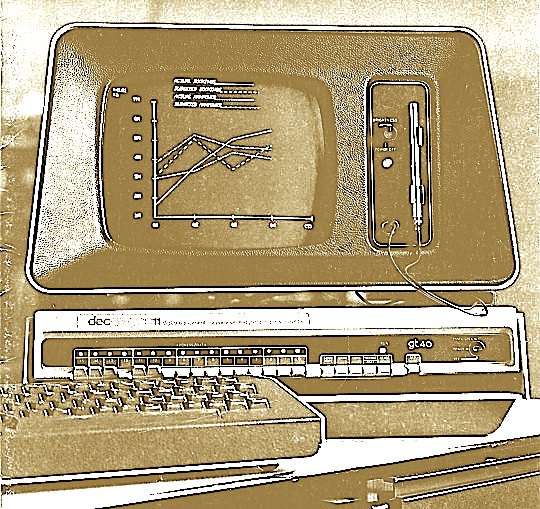
Vulpes hissed. “Aw, blips aren’t working. Must not be compatible with the ancient protocols on this machine — either that, or service is down.”
“Can’t be down,” Sevin said. “How would your blips get here? The only conceivable source is Earth’s orbital network, and that’s electromagnetic. It travels at light speed, Vulpes. Think about it: 24,000 years ago there was no network of any kind to bleed off its transmissions into interstellar space.”
“Not on Earth,” Vulpes said.
“Not on Earth?”
“Right. I mean, what if it started off-world? What if it came from here?”
“You’re suggesting that the Ogleans crossed the Milky Way to build us an Internet?”
Vulpes’ dark eyes glimmered wetly through his visor.
“Look around you,” Sevin continuted. “The planet’s surface is composed predominately of methane and xenolith, type unknown. Rads are metering 650 rem beyond the lander’s field. Nothing lives here to make an Internet.”
“We’ve been here three and a half hours, Sevin. One preliminary landing, one incomplete site survey. We don’t have spectroscopy or exobiometry — we haven’t even scoped the horizon yet. Is it just possible that we don’t know everything about OGLE-350c?”
Sevin didn’t have an answer. He stormed to the far wall, resistors cranking and torquing at his knees, and gave one of the loops of rock a smack.
“Hang on,” Vulpes said. “They’ve got Wikipedia.”
“Wiki — oh, come on.” Sevin threw his hands up in a vague, gloved sign of parody. “The Ogleans and the making of Wikipedia!” he exclaimed.
For Sevin and Vulpes the name “Wikipedia” glowed with the aura of antiquity. It was a distant ancestor of the Ubiquity of their own time, the network of thoughts and things taking the form of congenitally curious botmobs hurling themselves about in the cyberspatial kaleidoscope — ever worrying, ever tweaking the fields and entries in those vast, intercalating, quasi-living datastorms that seethed behind Ubiquity’s dappled surfaces. The powers and possibilities of Ubiquity made the device-bound Internet of old a creaky memory, suitable only for nostalgia salons and curiosity cabinets. But not even Ubiquity could reach here, these hundreds of parsecs from home.
Sevin watched Vulpes’ eyes as they flitted greedily in the glow of the screen. “People used to complain about Wikipedia all the time,” he said. “They accused it of systemic bias and inconsistencies, said that it favored consensus over credentials. It was a pretty crude tool.”
“They also said it compared well to the accuracy of the old printed encyclopedias,” Vulpes replied.
“That isn’t saying very much,” Sevin suggested.
Vulpes continued to stare at the screen and punch the keys. “Let’s see if — oh, it’s loading. Look, it’s in here! Only hang on —”
“What?” Although he preferred not to, Sevin returned to Vulpes and peered over his shoulder.
“I looked up my name,” Vulpes said, “and look what it has instead.”
Sevin peered in at the screen and read:
Vulpes is a genus of the Canidae family, members of which share the common name “fox.”
“I’m a fox, Sevin!” Vulpes exclaimed, laughing. “I’ve never seen one, of course. But that’s my name, that’s what it means.”
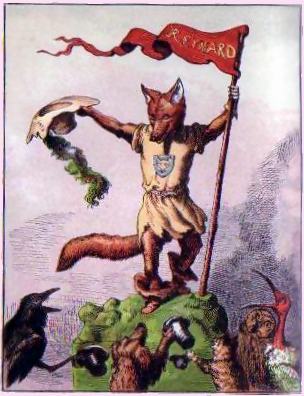
“Shhh!” Sevin replied. “I’m reading.” He leaned in closer. “It says they were smaller than dogs.”
Both men were quiet a moment. “Go ahead,” said Sevin, “look them up, too.”
Vulpes fumbled over the keys for a moment and clicked. A new page of text popped into view, accompanied by a picture of a grassy expanse occupied by a blond, avuncular creature with dark eyes and a stout rope of a tail.
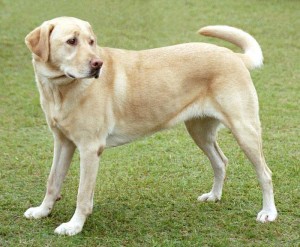
“A dog,” Vulpes said. “And grass. Grass, and a dog.”
“Never have seen one of those either,” Sevin said, speaking for them both. The resistors sang in the legs of his suit as he shifted his weight.
Vulpes sat in front of the terminal, pecking with one finger and watching the screen. “Oh,” he said after another moment, “This place is in here, too.”
“What do you mean?” Sevin replied.
“OGLE-350c,” Vulpes said. “They made an entry for it.” And there it was — an antique encyclopedia entry for the planet they were standing on, flickering on the screen in dumb, plodding text with a few diagrams and pictures strewn about.
Sevin leaned in and read:
Physical characteristics
OGLE-350c orbits around its star at an average distance of 2.0 to 4.1 AU, or an orbit that would fall between the orbits of Mars and Jupiter in our own solar system. The variation in distance is the range of error in measurement and calculation; the planet’s orbital elements are not known. Until this discovery, no small exoplanet had been found farther than 0.15 AUs from a main sequence star. The planet takes approximately 10 Earth years to orbit its star (located in the constellation Scorpius), which is thought to be a cool red dwarf (95% probability), or a white dwarf (4% probability), with a very slight chance that it is a neutron star or black hole (<1% probability).
“Look at this,” Vulpes hissed. “Check out what they knew about it.”
Sevin pondered, his eyes narrowing. “Who?” he asked.
“People,” Vulpes replied. “Us! Them! People in the olden days.”
“And look what they didn’t know,” Sevin answered. “They didn’t know the planet’s orbit, nothing about its nature and composition or seismic activity. They didn’t even know much about the star! Their means of exoplanetary detection were crude — gravitational lensing, data-pooling from networks of ground telescopes, that sort of thing. Roughly speaking, they had the same technology that Galileo used.”
“But there’s more…”
“It doesn’t matter!” Sevin almost cried. “What is it doing here? That’s what matters. It’s nearly three hundred degrees below zero, Vulpes. Screw your helmet back on and think. What is it doing here?”
“It says that this was the first small exoplanet discovered,” Vulpes offered. “Maybe that’s got something to do with this?”
“How so?”
“Maybe they knew their planet had been discovered, knew it was being watched.”
“I don’t see how that’s possible,” Sevin replied. “No, the only answer that makes any sense is this: another mission arrived before us and left this as some kind of bizarre calling card. Maybe it’s an ansible, maybe some emulation technology we’ve never encountered. I’m sure if we look around a little, we’ll figure out how they did it.”
They searched for a power supply like the old systems had, but found none; nor could they find a way to turn the display off or to access other systems. They searched the chamber for an hour, Sevin tagging the whole place for later reconstitution. And all the while the screen lit the chamber, its blue light receding into the dim upper reaches of the high, twisted ceiling. But there was no indication of the source of the terminal, its power supply, or of the communications system that supplied it with data. After they had pursued their fruitless search for what seemed like an hour, Sevin announced that time was running out on the lander’s anti-radiation field, and that they would need to return to the module while it recharged.
Later, Sevin tossed in his hammock inside the comfortably pressurized craft, pondering the words in the old Wikipedia entry. An orbit that would fall between the orbits of Mars and Jupiter…. Until this discovery, no small exoplanet had been found. Somehow, the tissue of tentative declarations made him powerfully nostalgic for the home system: for Earth and its Moon nestled between the tidal eddies of Jupiter and the protective emissions of Sol, for warm green things he had never even seen. Since leaving he had witnessed the death of cold stars and the churning of nebulae as big as the solar system; he had slept in suspension through more years than there were generations between Wikipedia’s age and his own. And now the time that had passed since that era seemed a shorter span than the reaches of space separating him from home. With these thoughts spinning in his head — with Earth’s colors swimming in his mind’s eye — he fell away into fitful sleep.
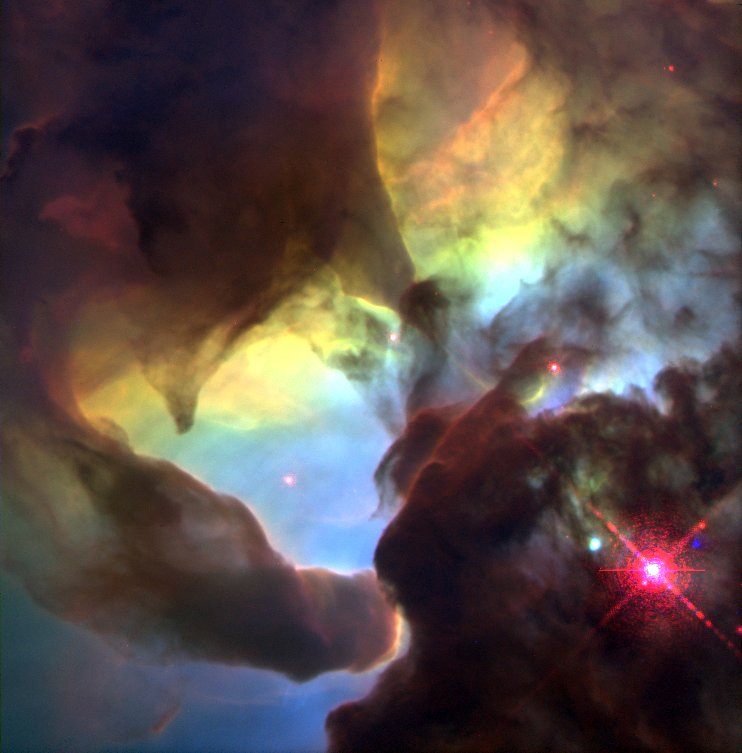
He awoke with a start some hours later, the airlock alarm pinging insistently and the cabin lights at full power. He rolled his head to the left; Vulpes’ hammock was empty. Sevin leaped up and looked out the landing survey window to see his companion’s helmeted figure making its bent way beyond the capsule’s fuzzy shadow and into the field of excrudescences and outcrops nearby. Sevin had no doubt where he was headed.
He finished the tedious suiting procedures in half the usual time, clambered out of the airlock, and sped down the path now marked in the frozen lith by the scuttle of their boots. Already he had tried to raise Vulpes by the usual frequencies, to no avail. In the cavern now, he rounded the glimmering corner and entered the blue-lit chamber, where he found Vulpes in the appointed place, seated at the terminal. At first he feared the worst: Vulpes’ arms hung at his sides, his body slumped slightly to one side. Sevin shook him, and was relieved when Vulpes’ visored face shook and gazed up at him. “Look what it says,” Vulpes stammered. “Look what it says — about us.”
“Vulpes, let’s get back to the lander now. The rad field isn’t fully charged; it has got less than half an hour of power left in it.”
“Just look!”
Sevin turned and read the entry:
Discovery
In 2201 CE, Corporation agents Sevin K. and Vulpes D. reached OGLE-350c. It was the fourth exoplanet of their tour of duty, which had begun at the superearth Centauri-f forty-two years before. There as elsewhere, they planned to spend several planetary missions making provisional descriptions of superficial features. Unfortunately it proved to be their last mission; the two agents never transmitted their ansible report from the OGLE system, and while electromagnetic telemetry later proved that they had established an orbit around OGLE-350c, they were never heard from again; cause of mission failure unknown.
He read it, and then he read it again, his fear climbing through the hairs along his spine. But in an instant fear became a kind of fierce clarity. “Let me in there,” he said, pushing Vulpes’ away.
Vulpes staggered. “What’re you going to do?” he asked.
“People used to modify these entries,” Sevin said.
“Who?”
“Anyone. Users.” Sevin’s eyes were darting, his fingers flexing. “Someone is making this up, and I’m going to unmake it.”
“Really? You can change entries yourself?”
“The Internet wasn’t like Ubiquity; it did what you told it to do.”
Vulpes gulped audibly. “Seem like it’s telling us what to do now.”
But Sevin wasn’t listening; he was intent on intuiting the workings of the system. He fumbled a few times before finding the edit field and setting the blinking line where he wanted text to enter. And slowly — punching the keys was hard enough with his gloved and unpracticed fingers — he began to enter text. “Sevin K. and Vulpes D. made their planetary EVA successfully and returned to their ship,” he typed.
“There,” he said. “A message for them.” He clicked to go back out to the main page of the entry — and moaned as he read the new entry. Instead of “made” it read “failed to make”— different from before, but amounting to the same thing.
“Somebody is out to get us,” Sevin said. “They’ve lured us here, it’s clear enough. Someone’s playing a game. It could be another mission–but no, how could that be? We’d know it, the system would’ve pinged us.”
“Sevin,” Vulpes said. “We’ve got to get away from here.”
Sevin looked at the terminal through narrowed eyes. “I’m not done yet.”
“But we’re running out of time.”
“I have to make them stop!” Sevin yelled. He had begun typing again; he had found the talk page, and was scanning for names and the timestamps of the edits.
Vulpes grabbed him by the wrist. Sevin’s helmeted head swiveled towards him as his free hand jabbed out and smashed Vulpes in the chest. It wasn’t a heavy blow, but Vulpes’ resistors couldn’t react quickly enough and he toppled heavily backwards, landing on his side.
“You had to come back out here,” Sevin hissed. He could hear Vulpes breathing over the link. “And now I am going to fix this entry.”
With that there was a squeal in both men’s ears; the lander’s anti-radiation field — all that was keeping them alive in this cosmically-blasted landscape — was running out of charge. The alarm signaling five minutes of power was driving itself insistently into their heads. Sevin fell back into the chair and set to the keys once more.
Vulpes watched him a full beat. “I’ll go back and try to give it an emergency recharge,” he said. And he left Sevin there to make his way back to the lander.
Upon his return Vulpes didn’t pause to egress from his suit, but rushed to the field generator and stoked the manual recharger with a few dozen cranks of the handle. But that added only a few more seconds of power to the field. Invisibly, cosmic radiation flooded back into the area from every direction; now, only inside the lander was it safe. Sevin in the tapered chamber would have been protected but a few moments longer; by now his anger had been burned away.
Vulpes went to the outer bulkhead window and watched the still landscape for some while, but Sevin never reappeared. He knew what he would find there, and knew he wouldn’t like it. Instead, he began the out-of-phase launch sequence. Soon the lander was blasting off, scarring the xenolith and vaporizing methane excrudescences. The planet’s surface fell dizzyingly away, and the rock with its hole was soon lost in a landscape that flattened and then curved back as the lander reached orbit. Vulpes knew that once he logged back in alone, the ship’s systems would automatically plot a course back to Earth. Once aboard, and after a few vague housekeeping tasks were completed, the only thing to do would be to submit to suspension.
Given the terrible words in the encyclopedia entry, which Sevin had strove to alter in vain, Vulpes felt a hollow pang of satisfaction as he filed the ansible report, beaming back to Earth the strange details of their ordeal — and his survival. He couldn’t place himself in suspension right away, however — the thought of even its sublime oblivion made him shudder — and for days he padded along throughout the compartments while OGLE-350c receded into the interstellar distances. One thought solaced him: when he was a boy, his grandfather said that the Internet of old was fickle and unstable, a fount of myths and lies; Wikipedia especially never could be trusted.
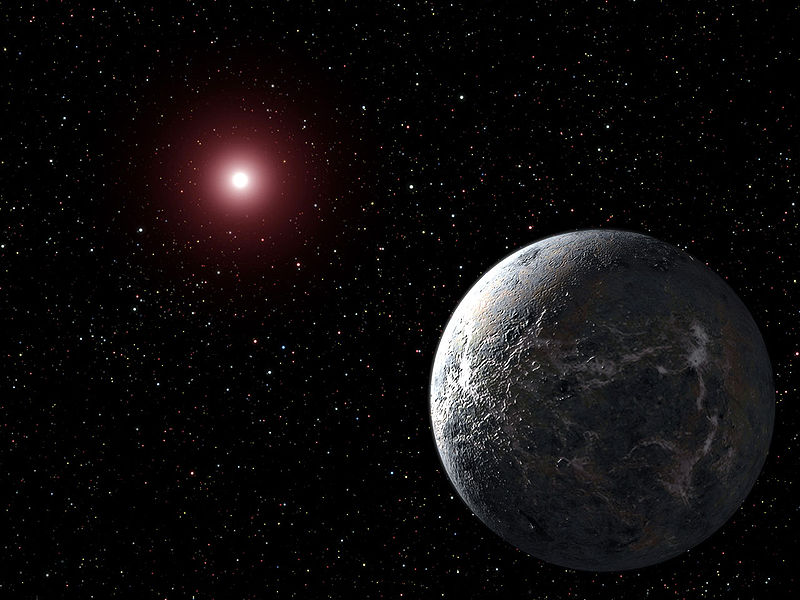
Text of Wikipedia entries based on the following, extant at date of writing: “Fox,” “Dog,” and “OGLE-2005-BLG-390Lb,” an exoplanet discovered in 2005. Images: NASA/Goddard Space Flight Center Scientific Visualization Studio; NASA, Hubble imagery of Apollo sites; NASA/Goddard Space Flight Center Scientific Visualization Studio; Additional credit to Zoltan G. Levay (STScI) ; Eugene Cernan, Apollo 17 Crew; DEC-GT40 terminal; Reynard the fox; Yellow Labrador Looking, by Djmirko; A. Caulet and NASA, Giant Twisters and Star Wisps in the Lagoon Nebula; OGLE-2005-BLG-390Lb NASA artist’s illustration, Wikimedia
For more fiction on HiLobrow, click here.
